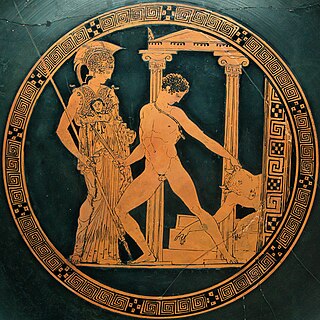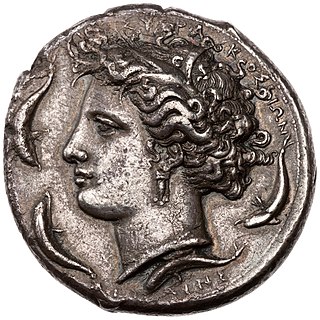Related Research Articles

In ancient Greek religion and mythology, Demeter is the Olympian goddess of the harvest and agriculture, presiding over crops, grains, food, and the fertility of the earth. Although Demeter is mostly known as a grain goddess, she also appeared as a goddess of health, birth, and marriage, and had connections to the Underworld. She is also called Deo. In Greek tradition, Demeter is the second child of the Titans Rhea and Cronus, and sister to Hestia, Hera, Hades, Poseidon, and Zeus. Like her other siblings except Zeus, she was swallowed by her father as an infant and rescued by Zeus.

In Greek mythology, Styx, also called the River Styx, is a goddess and river of the Underworld. Her parents were the Titans Oceanus and Tethys, and she was the wife of the Titan Pallas and the mother of Zelus, Nike, Kratos, and Bia. She sided with Zeus in his war against the Titans, and because of this, to honor her, Zeus decreed that the solemn oaths of the gods be sworn by the water of Styx.

Proserpina or Proserpine is an ancient Roman goddess whose iconography, functions and myths are virtually identical to those of Greek Persephone. Proserpina replaced or was combined with the ancient Roman fertility goddess Libera, whose principal cult was housed in the Aventine temple of the grain-goddess Ceres, along with the wine god Liber.

In ancient Roman religion, Ceres was a goddess of agriculture, grain crops, fertility and motherly relationships. She was originally the central deity in Rome's so-called plebeian or Aventine Triad, then was paired with her daughter Proserpina in what Romans described as "the Greek rites of Ceres". Her seven-day April festival of Cerealia included the popular Ludi Ceriales. She was also honoured in the May lustration (lustratio) of the fields at the Ambarvalia festival: at harvesttime: and during Roman marriages and funeral rites. She is usually depicted as a mature woman.

In ancient Roman religion and mythology, Liber, also known as Liber Pater, was a god of viticulture and wine, male fertility and freedom. He was a patron deity of Rome's plebeians and was part of their Aventine Triad. His festival of Liberalia became associated with free speech and the rights attached to coming of age. His cult and functions were increasingly associated with Romanised forms of the Greek Dionysus/Bacchus, whose mythology he came to share.
In Roman mythology, Reparator was the deity of the preparing fallow land for crops. He was one of the twelve helper gods of Ceres. His name was invoked during the Cerealia, along with the other eleven helper gods of Ceres.
In Roman mythology, Saritor was the god of hoeing and weeding. His name was invoked during the Cerealia, along with the other 11 helper gods of Ceres.
In Roman mythology, Vervactor was the deity of ploughing fallow land. He was one of the 12 helper gods of Ceres. His name was invoked during the Cerealia, along with the other 11 helper gods of Ceres.

In ancient Greek religion and mythology, the twelve Olympians are the major deities of the Greek pantheon, commonly considered to be Zeus, Poseidon, Hera, Demeter, Aphrodite, Athena, Artemis, Apollo, Ares, Hephaestus, Hermes, and either Hestia or Dionysus. They were called Olympians because, according to tradition, they resided on Mount Olympus.

In ancient Roman religion and mythology, Tellus Mater or Terra Mater is the personification of the Earth. Although Tellus and Terra are hardly distinguishable during the Imperial era, Tellus was the name of the original earth goddess in the religious practices of the Republic or earlier. The scholar Varro (1st century BC) lists Tellus as one of the di selecti, the twenty principal gods of Rome, and one of the twelve agricultural deities. She is regularly associated with Ceres in rituals pertaining to the earth and agricultural fertility.

Interpretatio graeca, or "interpretation by means of Greek [models]", refers to the tendency of the ancient Greeks to identify foreign deities with their own gods. It is a discourse used to interpret or attempt to understand the mythology and religion of other cultures; a comparative methodology using ancient Greek religious concepts and practices, deities, and myths, equivalencies, and shared characteristics.

In Greek mythology, Arethusa was a nymph who fled from her home in Arcadia beneath the sea and came up as a fresh water fountain on the island of Ortygia in Syracuse, Sicily.

Greek mythology is the body of myths originally told by the ancient Greeks, and a genre of ancient Greek folklore, today absorbed alongside Roman mythology into the broader designation of classical mythology. These stories concern the ancient Greek religion's view of the origin and nature of the world; the lives and activities of deities, heroes, and mythological creatures; and the origins and significance of the ancient Greeks' cult and ritual practices. Modern scholars study the myths to shed light on the religious and political institutions of ancient Greece, and to better understand the nature of myth-making itself.
The Aventine Triad is a modern term for the joint cult of the Roman deities Ceres, Liber and Libera. The cult was established c. 493 BC within a sacred district (templum) on or near the Aventine Hill, traditionally associated with the Roman plebs. Later accounts describe the temple building and rites as "Greek" in style. Some modern historians describe the Aventine Triad as a plebeian parallel and self-conscious antithesis to the Archaic Triad of Jupiter, Mars and Quirinus and the later Capitoline Triad of Jupiter, Minerva and Juno. The Aventine Triad, temple and associated ludi served as a focus of plebeian identity, sometimes in opposition to Rome's original ruling elite, the patricians.

Roman mythology is the body of myths of ancient Rome as represented in the literature and visual arts of the Romans, and is a form of Roman folklore. "Roman mythology" may also refer to the modern study of these representations, and to the subject matter as represented in the literature and art of other cultures in any period. Roman mythology draws from the mythology of the Italic peoples and shares mythemes with Proto-Indo-European mythology.
Insitor was, in Ancient Roman religion, a minor agricultural deity involved with the sowing of crops. His name was invoked during the Cerealia, along with the other 11 helper gods of Ceres.

In ancient Roman religion and myth, Hercules was venerated as a divinized hero and incorporated into the legends of Rome's founding. The Romans adapted Greek myths and the iconography of Heracles into their own literature and art, but the hero developed distinctly Roman characteristics. Some Greek sources as early as the 6th and 5th century BC gave Heracles Roman connections during his famous labors.

In Greek and Roman mythology, Creusa is the wife of Aeneas, and the mother of Ascanius. According to Apollodorus, she is the daughter of Priam and Hecuba. A number of sources describe her presence during the sack of Troy, with her often fleeing the city alongside her husband. In Virgil's Aeneid, Creusa is lost in the confusion while their family is trying to escape, leading Aeneas to turn back to look for her; there he is met with her shade, which foretells of his future journey to Hesperia, where he is told he will marry a different woman.
In Greek mythology Aristaeus is one of the Giants, the earth-born children of Gaia. The Sicilian Aristaeus took part in the battle against the Olympian gods, and he had the distinction of being the sole survivor of that battle.
References
- ↑ Dumézil, Georges; Krapp, Philip (1996). Archaic Roman religion (Johns Hopkins ed., [Rev. ed.]. ed.). Baltimore [u.a.]: Johns Hopkins Univ. Press. p. 35. ISBN 9780801854804.
- ↑ Price, Mary Beard; John North; Simon (1999). A history. Cambridge: Cambridge University Press. p. 11. ISBN 9780521316828.
{{cite book}}: CS1 maint: multiple names: authors list (link) - ↑ Spaeth, Barbette Stanley (2010). The Roman Goddess Ceres. University of Texas Press. p. 36. ISBN 9780292785779.
- ↑ "A Dictionary of Greek and Roman Antiquities (1890), AGRICULTU´RA". www.perseus.tufts.edu. Retrieved 4 February 2017.